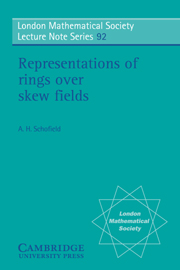Book contents
- Frontmatter
- Contents
- Preface
- Part I Homomorphisms to simple artinian rings
- 1 Hereditary rings and projective rank functions
- 2 The coproduct theorems
- 3 Projective rank functions on ring coproducts
- 4 Universal localisation
- 5 Universal homomorphisms from hereditary to simple artinian rings
- 6 Homomorphisms from hereditary to von Neumann regular rings
- 7 Homomorphisms from rings to simple artinian rings
- Part II Skew subfields of simple artinian coproducts
- References
- Index
4 - Universal localisation
Published online by Cambridge University Press: 19 March 2010
- Frontmatter
- Contents
- Preface
- Part I Homomorphisms to simple artinian rings
- 1 Hereditary rings and projective rank functions
- 2 The coproduct theorems
- 3 Projective rank functions on ring coproducts
- 4 Universal localisation
- 5 Universal homomorphisms from hereditary to simple artinian rings
- 6 Homomorphisms from hereditary to von Neumann regular rings
- 7 Homomorphisms from rings to simple artinian rings
- Part II Skew subfields of simple artinian coproducts
- References
- Index
Summary
One of the first constructions developed in the theory of rings was localisations for commutative rings as a way of passing from a commutative domain to its field of fractions. When the theory of non-commutative rings was developed, it was noticed that an analogue of this was possible for suitable sets of elements in a ring provided that they satisfied the Ore condition. This method was shown to be of particular importance when Goldie showed that for a prime Noetherian ring the set of non-zero-divisors of the ring satisfied the Ore condition and the Ore localisation at this set was a simple artinian ring.
One construction that was considered but rejected on the grounds that at the time nothing could be proved about it was the construction of adjoining universally the inverses to a subset of elements of the ring. Of course, the Ore localisation is a special case of this construction. However, in studying the homomorphisms from rings to skew fields, Cohn was forced to study a generalisation of this construction. He showed that the set of a matrices over a ring R that become invertible under an epimorphism to a skew field F determine the epimorphism; more specifically, the ring obtained by adjoining universally the inverses to these matrices is a local ring L whose residue skew field is F. Of course, the homomorphism R → L → F is our original epimorphism. For the first time, therefore, the construction of adjoining universally the inverses of some set of matrices required serious consideration; this was taken a step further by Bergman who considered the construction of adjoining universally the inverses to a set of maps between f.g. projectives.
- Type
- Chapter
- Information
- Representations of Rings over Skew Fields , pp. 50 - 67Publisher: Cambridge University PressPrint publication year: 1985



